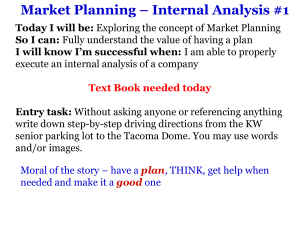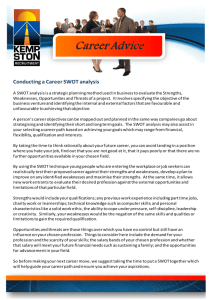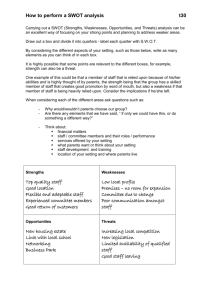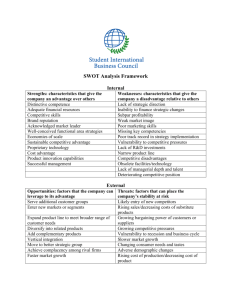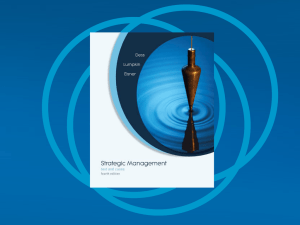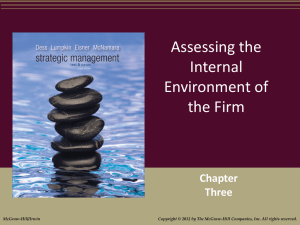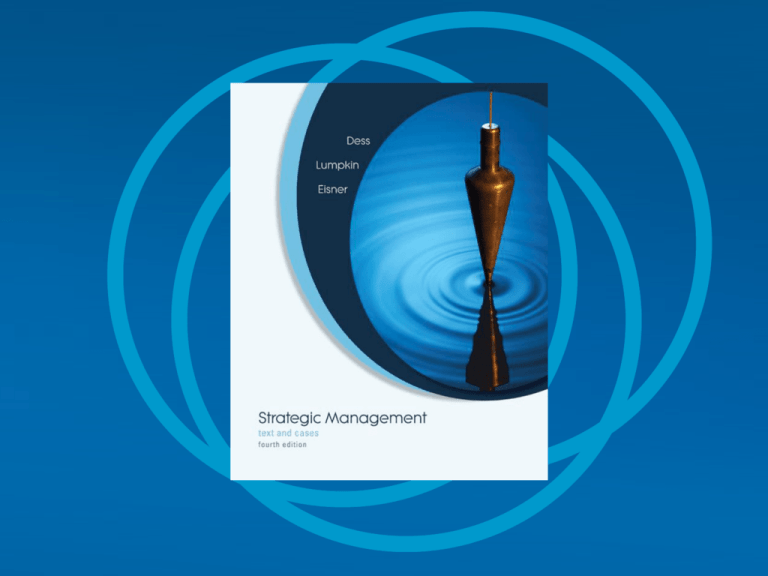
3
Assessing the Internal
Environment of the Firm
McGraw-Hill/Irwin
Strategic Management: Text and Cases, 4e
Copyright © 2008 The McGraw-Hill Companies, Inc. All rights reserved.
3-3
Learning Objectives
•
After reading this chapter, you should have a good
understanding of:
-
-
The benefits and limitations of SWOT analysis in conducting an
internal analysis of the firm.
The primary and support activities of a firm’s value chain.
How value-chain analysis can help managers create value by
investigating relationships among activities within the firm and
between the firm and its customers and suppliers.
The resource-based view of the firm and the different types of
tangible and intangible resources, as well as organizational
capabilities.
3-4
Learning Objectives
•
After reading this chapter, you should have a good
understanding of:
-
-
-
The four criteria that a firm’s resources must possess to
maintain a sustainable advantage and how value created can
be appropriated by employees.
The usefulness of financial ratio analysis, its inherent
limitations, and how to make meaningful comparisons of
performance across firms.
The value of recognizing how the interests of a variety of
stakeholders can be interrelated.
How firms are using Internet technologies to add value and
achieve unique advantages. (Appendix)
3-5
Purpose of Internal Analysis
• An organization’s future success depends on
its own internal conditions as well as external
conditions
• Managers need to be able to identify
- Strengths that the company can relay on in
order to compete
- Weaknesses that need to be corrected or
minimized as competitive factors
3-6
Managers must understand
–The role of resources, capabilities, and
distinctive competencies in the process
by which companies create value and
profit
–The importance of superior efficiency,
innovation, quality, and responsiveness
to customers
–The sources of their company’s
competitive advantage (strengths and
weaknesses)
3-7
Competitive Advantage
•
•
•
The collection of factors that sets a
company apart from its competitors
and gives it a unique position in the
industry/market
Means to add value for stakeholders
Focus especially on adding value for
customers
3-8
Core Competence(ies)
A unique set of lasting capabilities that
a company relies on to achieve
competitive advantage and add value
• Innovation
• Efficiency
• Customer Responsiveness
• Quality
• Special Expertise
3-9
The Limitations of SWOT Analysis
• Strengths may not lead to an advantage
• SWOT’s focus on the external environment is too
narrow
• SWOT gives a one-shot view of a moving target
• SWOT overemphasizes a single dimension of
strategy
• Does not lead to rigorous examination of
components to external and internal
environments
3 - 10
Question
Which of the following is true regarding the SWOT analysis?
A) By itself, the SWOT analysis often helps a firm develop
competitive advantages that can be sustained over time.
B) The SWOT analysis's not the best starting point for creating
strategies.
C) The SWOT analysis simulates self-reflection and group
discussions on how to improve a firm and position it for
success.
D) The SWOT analysis is not a tried-and-true tool of strategic
analysis.
3 - 11
Value-Chain Analysis
• Sequential process of value-creating activities
• The amount that buyers are willing to pay for
what a firm provides them
• Value is measured by total revenue
• Firm is profitable to the extent the value it
receives exceeds the total costs involved in
creating its product or service
3 - 12
Example
• IBM Electronics Value Chain Management helps
companies save money by streamlining their value chain.
• The benefits of streamlining a business with value chain
management include:
- Lower infrastructure costs associated with collaboration.
- Create commonality in parts and suppliers.
- Control inventory by getting the supply chain talking to the
demand chain.
- Cut transaction costs by integrating with public and private
exchanges.
- Deliver products to market faster while minimizing risk and
capital investment.
Source: www.ibm.com
3 - 13
The Value Chain
Adapted from Exhibit 3.1 The Value Chain: Primary and Support Activities
Source: Adapted with permission of The Free Press, a division of Simon & Schuster, Inc., from Competitive Advantage:
Creating and Sustaining Superior Performance by Michael E. Porter.
3 - 14
Value Chain Interpretation
• Represents a company or any organization
• Simplified illustration of all activities that an
organization must perform
• Framework for analyzing a company’s
strengths and weaknesses
• Margin represents profit- expand margin by
- Being able to charge a higher price
- Operating at a lower cost within the Value
Chain
3 - 15
Primary Activity: Inbound Logistics
• Associated with receiving, storing and distributing
inputs to the product
- Location of distribution facilities
- Material and inventory control systems
- Systems to reduce time to send “returns” to
suppliers
- Warehouse layout and designs
3 - 16
Primary Activity: Operations
• Associated with transforming inputs into the final
product form
-
Efficient plant operations
Appropriate level of automation in manufacturing
Quality production control systems
Efficient plant layout and workflow design
3 - 17
Primary Activity: Outbound Logistics
• Associated with collecting, storing, and
distributing the product or service to buyers
-
Effective shipping processes
Efficient finished goods warehousing processes
Shipping of goods in large lot sizes
Quality material handling equipment
3 - 18
Primary Activity: Marketing and Sales
• Associated with purchases of products and
services by end users and the inducements used
to get them to make purchases
-
Highly motivated and competent sales force
Innovative approaches to promotion and advertising
Selection of most appropriate distribution channels
Proper identification of customer segments and needs
Effective pricing strategies
3 - 19
Primary Activity: Service
• Associated with providing service to enhance or
maintain the value of the product
- Effective use of procedures to solicit customer
feedback and to act on information
- Quick response to customer needs and emergencies
- Ability to furnish replacement parts
- Effective management of parts and equipment
inventory
- Quality of service personnel and ongoing training
- Warranty and guarantee policies
3 - 20
Support Activity:
General Administration
Firm Infrastructure
• Typically supports the entire value chain and not individual
activities
- Effective planning systems
- Ability of top management to anticipate and act on key
environmental trends and events
- Ability to obtain low-cost funds for capital expenditures
and working capital
- Excellent relationships with diverse stakeholder groups
- Ability to coordinate and integrate activities across the
value chain
- Highly visible to inculcate organizational culture,
reputation, and values
3 - 21
Support Activity:
Human Resource Management
• Activities involved in the recruiting, hiring,
training, development, and compensation of all
types of personnel
- Effective recruiting, development, and retention
mechanisms for employees
- Quality relations with trade unions
- Quality work environment to maximize overall
employee performance and minimize absenteeism
- Reward and incentive programs to motivate all
employees
3 - 22
Support Activity:
Technology Development
• Related to a wide range of activities and those
embodied in processes and equipment and the
product itself
- Effective R&D activities for process and product
initiatives
- Positive collaborative relationships between R&D and
other departments
- State-of-the art facilities and equipment
- Culture to enhance creativity and innovation
- Excellent professional qualifications of personnel
- Ability to meet critical deadlines
3 - 23
Support Activity: Procurement
• Function of purchasing inputs used in the firm’s
value chain
- Procurement of raw material inputs
- Development of collaborative “win-win” relationships
with suppliers
- Effective procedures to purchase advertising and
media services
- Analysis and selection of alternate sources of inputs to
minimize dependence on one supplier
- Ability to make proper lease versus buy decisions
3 - 24
Applying Value Chain Analysis
• Framework for identifying company’s strengths
and weaknesses
• Means to focus on where the company’s core
competencies exist and can be used to
achieve competitive advantage and add value
• Comparison with competitors reveals
opportunities for improving company’s
competitive position
3 - 25
Interrelationships among Value-Chain
Activities within and across Organizations
• Importance of relationships among value
activities
- Interrelationships among activities within the firm
- Relationships among activities within the firm and with
other organization (e.g., customers and suppliers)
3 - 26
Resource-Based View of the Firm
• Two perspectives
- The internal analysis of phenomena within a company
- An external analysis of the industry and its competitive
environment
• Three key types of resources
- Tangible resources
- Intangible resources
- Organizational capabilities
3 - 27
Resource-Based View (RBV)
1. RBV is a method of analyzing and identifying
a firm’s strategic advantages based on
examining its distinct combination of assets,
skills, capabilities, and intangibles
2. The RBV’s underlying premise is that firms
differ in fundamental ways because each
firm possesses a unique “bundle” of
resources
3. Each firm develops competencies from these
resources, and these become the source of
the firm’s competitive advantages
3 - 28
Types of Resources:
Tangible Resources
• Relatively easy to identify, and include physical
and financial assets used to create value for
customers
• Financial resources
- Firm’s cash accounts
- Firm’s capacity to raise equity
- Firm’s borrowing capacity
• Physical resources
- Modern plant and facilities
- Favorable manufacturing locations
- State-of-the-art machinery and equipment
3 - 29
Types of Resources:
Tangible Resources
• Technological resources
- Trade secrets
- Innovative production processes
- Patents, copyrights, trademarks
• Organizational resources
- Effective strategic planning processes
- Excellent evaluation and control systems
3 - 30
Types of Resources:
Intangible Resources
• Difficult for competitors (and the firm itself) to
account for or imitate, typically embedded in
unique routines and practices that have evolved
over time
- Human
•
•
•
•
Experience and capabilities of employees
Trust
Managerial skills
Firm-specific practices and procedures
3 - 31
Types of Resources:
Intangible Resources
• Innovation and creativity
- Technical and scientific skills
- Innovation capacities
• Reputation
- Brand name
- Reputation with customers
- Reputation with suppliers
3 - 32
Types of Resources:
Organizational Capabilities
• Competencies or skills that a firm employs to
transform inputs to outputs, and capacity to
combine tangible and intangible resources to
attain desired end
-
Outstanding customer service
Excellent product development capabilities
Innovativeness of products and services
Ability to hire, motivate, and retain human capital
3 - 33
Firm Resources and
Sustainable Competitive Advantages
Is the resource or
capability…
Valuable
Rare
Difficult to imitate
Implications
• Neutralize threats and
exploit opportunities
• Not many firms possess
• Physically unique
• Path dependency
• Causal ambiguity
• Social complexity
Difficult to substitute
• No equivalent strategic
resources or capabilities
Adapted from Exhibit 3.7 Four Criteria for Assessing Sustainability of Resources and Capabilities
3 - 34
Question
In the bookseller industry, can different firm
resources become strategic substitutes for
Amazon.com? Explain.
3 - 35
Criteria for Sustainable Competitive
Advantage and Strategic Implications
Exhibit 3.8 Criteria for Sustainable Competitive Advantage and Strategic Implications
Source; Adapted from J. Barney, “Firm Resources a Sustained Competitive Advantage,
‘ Journal of Management 17 (1991), pp. 99-120.
3 - 36
Evaluating Firm Performance
• Two approaches for evaluating firm performance
- Financial ratio analysis
•
•
•
•
•
Balance sheet
Income statement
Historical comparison
Comparison with industry norms
Comparison with key competitors
- Balanced scorecard (stakeholder perspective)
• Employees
• Customers
• Owners
3 - 37
Financial Ratio Analysis
• Five SIX types of financial ratios
-
Short-term solvency or liquidity
Long-term solvency measures
Asset management (or turnover)
Profitability
Market value
Growth
• Meaningful ratio analysis must include
- Analysis of how ratios change over time
- How ratios are interrelated
3 - 38
The Balanced Scorecard
• Provides a meaningful integration of many issues
that come into evaluating a firm’s performance
• Four key perspectives
- How do customers see us? (customer perspective)
- What must we excel at? (internal perspective)
- Can we continue to improve and create value?
(innovation and learning perspective)
- How do we look to shareholders? (financial
perspective)
3 - 39
Customer Perspective
• Time
• Quality
• Performance and service
• Cost
3 - 40
Internal Business Perspective
• Processes
- Cycle time
- Quality
- Employee Skills
- Productivity
• Decisions
• Actions
• Coordination
• Resources and capabilities
3 - 41
Innovation and Learning Perspective
• Introduction of new products and services
• Greater value for customers
• Increased operating efficiencies
3 - 42
Example
•
The world’s 10 most innovative companies, according to
Business Week in 2007 are:
1. Apple
2. Google
3. Toyota Motor
4. General Electric
5. Microsoft
6. Proctor & Gamble
7. 3M
8. Walt Disney Co.
9. IBM
10. Sony
Source: www.businessweek.com
3 - 43
Financial Perspective
• Profitability
• Growth
• Shareholder value
• Increased market share
• Reduced operating expenses
• Higher asset turnover
3 - 44
Potential Limitations of the
Balanced Scorecard
• Lack of a clear strategy
• Limited or ineffective executive sponsorship
• Too much emphasis on financial measures rather
than nonfinancial measures
• Poor data on actual performance
• Inappropriate links to scorecard measures to
compensation
• Inconsistent or inappropriate Terminology
3 - 45
Combining Internal and
External Analyses
• Internal and External Analyses commonly referred to
as SWOT:
- Strengths
- Weaknesses
- Opportunities
- Threats
• Strengths and Weaknesses identified from Internal
Analysis
• Opportunities and Threats identified from External
Analyses
3 - 46
Internal Analysis
• Strengths and Weaknesses identified through
the use of tools such as:
- Vision, Mission, Objectives
- Stakeholder Analysis
- Core Competencies
- Value Chain
- Balanced Scorecard
- Financial Analysis
3 - 47
External Analysis
• Opportunities and Threats identified through
the use of tools such as:
- General Environment Assessment
- Five Force Analysis
- Key Success Factors in Industry
- Competitive Changes during Industry
Evolution
- Strategic Groups
- National Competitive Advantage
3 - 48
Results of Internal and External
Analysis
• Requires creative interpretation
• Understanding of company’s competitive
position in its industry
• Identification of strategic issues the company
faces
• Strategic issues
- Represent dangers to the company’s longterm survival
- Suggest areas where the company should
concentrate its efforts in order to grow
3 - 49
Internal Analysis
External Analysis
•Strengths
•Opportunities
•Weaknesses
Tools
•Threats
Strategic
Issues
Strategic
Alternatives
Strategy
Tools




